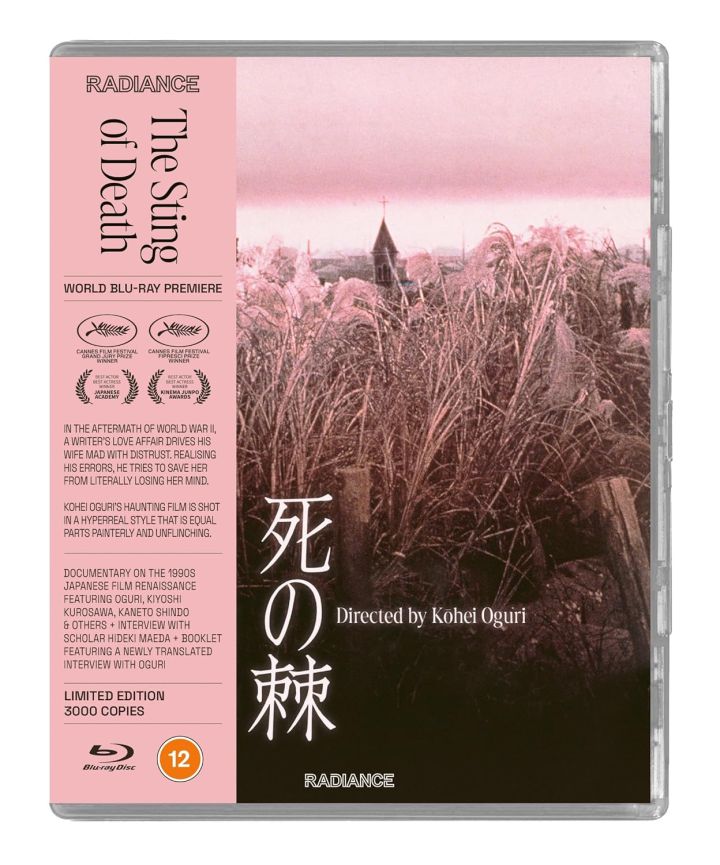
The man has cheated on his wife. This is not in dispute. It has hurt her to her core. She wants to kill herself and let him go back to this woman. He won’t allow it. After tumult and strife, they come to an agreement. He won’t lie to her anymore; she won’t bring up the past.
But it comes up, again, and again. She can’t forget, and even when the family is on the up, she has to bring up the past. Her pain. Her distrust.
Buy The Sting of Death Blu-rayThe Sting of Death (1990) is an elliptical, strange film. It’s simultaneously hyper-realistic and dreamlike. The opening scene focuses entirely on the wife, Miho, as she complains to her unseen husband, Toshio, who refuses to let her kill herself. Then we see him, in complete isolation, talking to her. Then the composition shifts, and we’re surprised to see the two are in the same room, sitting next to each other but not looking at one another.
As the film traces the dissolution of this family, director Kohei Oguri constantly employs these compositional strategies to alienate the characters from one another. Japanese filmmakers love framing within the frame, and there is a constant use of occluding walls and windows so, when characters talk to each other, we cannot see both at once. It creates a distancing effect, where the film wants us to look objectively at a family in freefall.
The story of the film is simple. The wife is mad at the husband. He agrees not to see his mistress anymore. They decide to go on with life, but time after time she dredges up the past. She obsesses on his infidelity. It drives Toshio himself to try to commit suicide. There’s a bizarre scene where the two commit to catching pneumonia, to see who can die first, and sit semi-naked in their living room. Then they try to hang themselves, mutually. It doesn’t work out.
In the outline, The Sting of Death sounds like a rather turgid story of a scorned woman trying to punish her husband, who might deserve it. But the story is more complicated. The film is set in the aftermath of WWII. He is a surviving kamikaze pilot (watch Godzilla Minus Zero to see how well they were received). There are sequences that seem to be dreams, or memories, of him dragging a ship through a tunnel. They do not announce their significance, but they speak to a larger burden on the man than just being a base cheater.
There’s an easily missed, but key note to the story when Toshio eventually commits Miho to an asylum. The scene is set like the evil husband sending the innocent wife to unfair containment. But at one point, he tells the doctors to not give her electro-shock therapy. She doesn’t like it.
This implies that she has had it before, and that her mental problems predate his infidelity. It puts so much of what has happened before in a different light, and signals Toshio might not just be a villainous cheater, but a man in an untenable position.
It’s typical of Japanese cinema to not fill in the blanks. The audience is supposed to read between the lines and create understanding on their own and not be led like a bull with a ring in his nose. The value of a film like this, made with meticulous quality and fascinating detail, is that the audience gets to confront their own notions and biases. I have no sympathy with a cheater… but the man’s wife is crazy. Every comfortable moment they have, she torpedoes. She demands her husband go with her while shopping, then tells him to leave her alone. She’s infuriating.
And she’s been wronged. The Sting of Death invites interpretation. It invites debate. It is so beautifully framed, intentionally ignoring many of the conventions of filmmaking. As a fan of cinematography, I love watching the many off-angle set-ups and created framing in this movie. My favorite might be when Miho is in conversation with her husband, and the shot changes, and he is completely cut off by the scenery. It was as if she was talking just to herself. Beautiful.
The Sting of Death is a real cinematic feat. It’s also very much an art film. The story is told through composition, through emotional editing. It’s not straightforward what is actually happening. There are things that might be dream sequences. The film does not make it clear. It’s artsy. I feel invigorated by movies that make me do some work. Other audiences might think that’s annoying. I appreciate that. The Sting of Death is ultimately about two incompatible people who find a connection in insanity. It’s not much fun. It’s also beautiful.
The Sting of Death has been released on Blu-ray by Radiance films. Videos extras on the disc include “Japanese Cinema: New Territories” (57 min), an excellent French language documentary on the Japanese cinema renaissance in the ’90s from 2011, and a new interview with film scholar Hideki Maeda (20 min.) There’s also a booklet with a newly translated interview with the director, Kohei Oguri.